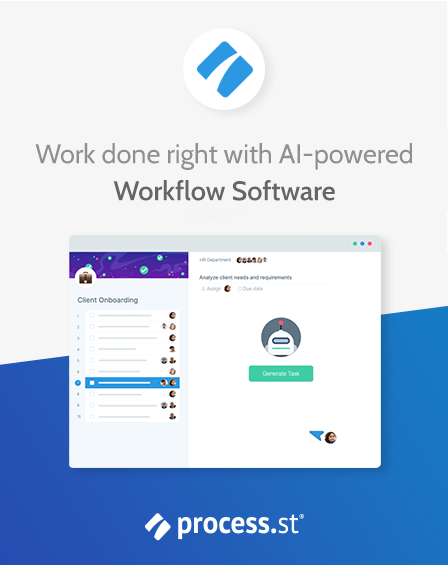Get work done right, and right-on-time with our industry leading BPM platform.
Here’s How to Choose the Right Business Process Management Solution
Business Process Management Solution (BPM) stands as the vigilant process gatekeeper, ensuring the flow of operations doesn’t falter.
Understanding what BPM actually entails is the first step in harnessing its potential to streamline workflows and enhance productivity.
At the heart of BPM lies the quest for improved performance—a pursuit critical to any business’s survival and success.
Thus, recognizing the essential features, from workflow management to real-time analytics, that transform a standard BPM tool into an indispensable asset is a chief concern for decision-makers.
It determines not just an organization’s efficiency but also its agility.
- What is Business Process Management?
- Top Business Process Management Solutions
- The Importance of Business Process Management
- Key Features to Consider in a Business Process Management Solution
- Types of Business Process Management Solutions
- Factors to Consider when Choosing a Business Process Management Solution
What is Business Process Management?
Business Process Management (BPM) is a systematic approach that helps organizations optimize and streamline their internal workflows, ensuring greater operational efficiency and performance.
By dissecting complex procedures into simpler tasks, BPM aids companies in consistently refining their process architecture, enabling enhanced agility in their functions.
At its core, BPM involves meticulously analyzing existing processes, accelerating workflows through automation, and pursuing continuous process optimization.
This relentless pursuit of process improvement significantly reduces inefficiencies such as bottlenecks and redundancies, ultimately leading to cost reductions.
Moreover, BPM emphasizes the importance of transparency and open communication, thereby promoting employee engagement across the organizational hierarchy.
A key benefit of BPM is that it provides a structured platform for organizations to maintain a laser focus on process excellence, which directly correlates with improved customer satisfaction.
By prioritizing the smooth operation of business processes, from customer onboarding to project management, companies can deliver exceptional customer experiences, resulting in heightened customer loyalty.
In essence, BPM is not just a tool or a software solution but a strategic philosophy that aligns all aspects of an organization towards a unified goal of efficiency and continuous improvement.
Top Business Process Management Solutions
Process Street
Process Street is a top business process management software known for its simplicity and efficiency. It helps teams create, track, and automate workflows, providing a comprehensive solution for business process management workflows.
Pros:
- User-friendly interface
- Powerful automation features
- Excellent collaboration tools
- Offers free business process management tools
Cons:
- May be pricey for startups
Bizagi
Bizagi is a comprehensive business process management software that helps businesses model, automate, and optimize their workflows. It is designed to handle complex business process management workflows efficiently.
Pros:
- User-friendly process modeling
- Strong automation features
- Good integration capabilities
- Offers free business process management tools
Cons:
- Can be complex to implement
- Limited customization options
Appian
Appian is a low-code BPM platform that enables organizations to create custom business process management workflows. It focuses on speed and ease of use, making it a popular choice for enterprises.
Pros:
- Low-code development
- Fast deployment
- Robust automation features
- Scalable for enterprise use
Cons:
- High cost
- Steep learning curve for advanced features
Pega
Pega is a powerful BPM tool that provides end-to-end automation of business processes. It is well-suited for enterprises looking to optimize complex business process management workflows.
Pros:
- Advanced automation capabilities
- Strong AI and machine learning integration
- Good for complex enterprise workflows
- Includes free business process management software options
Cons:
- Expensive
- Can be difficult to set up
IBM Business Automation Workflow
IBM Business Automation Workflow combines business process management and case management capabilities. It helps organizations manage and automate their workflows effectively.
Pros:
- Robust BPM and case management features
- Strong integration with other IBM products
- Suitable for large enterprises
- Good for complex business process management workflows
Cons:
- High cost
- Complex implementation
TIBCO BPM
TIBCO BPM is a comprehensive platform for modeling, automating, and optimizing business processes. It is designed for enterprises looking for robust business process management tools.
Pros:
- Powerful process modeling
- Strong analytics and reporting
- Good integration options
- Suitable for large-scale enterprise workflows
Cons:
- Steep learning curve
- Expensive
Oracle BPM
Oracle BPM is a part of the Oracle Fusion Middleware suite, providing robust tools for business process management workflows. It is ideal for organizations looking to streamline their processes.
Pros:
- Comprehensive BPM features
- Strong integration with Oracle products
- Good for complex workflows
- Scalable for enterprise use
Cons:
- High cost
- Complex setup
Bonita BPM
Bonita BPM is an open-source business process management software that helps organizations model, automate, and monitor their workflows. It is known for its flexibility and customization options.
Pros:
- Open-source and free business process management software options
- Highly customizable
- Good integration capabilities
- Strong community support
Cons:
- Steep learning curve
- Limited out-of-the-box features
Signavio
Signavio offers a cloud-based BPM platform designed to model, analyze, and optimize business processes. It is suitable for organizations looking for comprehensive business process management tools.
Pros:
- User-friendly process modeling
- Strong analytics and reporting
- Good collaboration features
- Includes free business process management tools
Cons:
- Can be expensive
- Limited customization for advanced features
ARIS BPM
ARIS by Software AG is a robust BPM tool that provides comprehensive business process management workflows. It is designed to help organizations optimize and automate their processes.
Pros:
- Strong process modeling and analysis
- Good integration options
- Scalable for large enterprises
- Offers free business process management tools
Cons:
- Complex setup
- High cost
Metastorm BPM
Metastorm BPM, now part of OpenText, offers a comprehensive suite of tools for business process management workflows. It is known for its strong process automation and optimization features.
Pros:
- Powerful automation tools
- Good integration capabilities
- Suitable for large enterprises
- Strong document management workflow
Cons:
- Expensive
- Steep learning curve
Camunda
Camunda is an open-source BPM platform that focuses on process automation and optimization. It is designed for developers and technical teams looking for flexible business process management tools.
Pros:
- Open-source and free business process management software options
- Highly customizable
- Strong developer support
- Good for complex workflows
Cons:
- Requires technical expertise
- Limited out-of-the-box features
Ultimus
Ultimus provides a comprehensive BPM suite that helps organizations automate and optimize their business process management workflows. It is suitable for enterprises looking for robust BPM solutions.
Pros:
- Strong process automation features
- Good integration options
- Scalable for large enterprises
- Offers free business process management tools
Cons:
- High cost
- Complex setup
AgilePoint
AgilePoint is a low-code BPM platform that allows organizations to create and manage custom business process management workflows. It is designed to be flexible and easy to use.
Pros:
- Low-code development
- Fast deployment
- Strong integration options
- Good for complex workflows
Cons:
- Expensive
- Learning curve for advanced features
WorkflowGen
WorkflowGen is a BPM platform that helps organizations design, deploy, and manage their business process management workflows. It is known for its flexibility and strong automation capabilities.
Pros:
- User-friendly interface
- Strong automation features
- Good integration options
- Offers free business process management software options
Cons:
- Limited advanced features
- Can be complex to set up
The Importance of Business Process Management
Business Process Management (BPM) is a methodical approach to improving an organization’s workflow by making it more reliable and adaptable to change.
By embracing BPM, a business can pinpoint and amend process inefficiencies, leading to significant cost reductions and a more streamlined operational model.
BPM solutions are instrumental in optimizing business agility, enabling companies to constantly refine their processes for optimal performance.
BPM software plays an essential role, in simplifying complex processes and enhancing customer satisfaction by automating repetitive tasks and removing workflow bottlenecks.
This automation is crucial for processes like approvals, customer onboarding, and documentation management, which become more efficient and error-free; human errors are significantly reduced, ensuring faster throughput in areas such as quoting and sample delivery.
Moreover, by deploying BPM systems, businesses can expect a rise in sales and revenue due to the precision and speed of their enhanced processes.
Key Features to Consider in a Business Process Management Solution
When vetting the options for a business process management solution, you should look for several key features.
These will ensure that the tool you select not only serves your business’s immediate needs but is also scalable for future requirements.
User-friendly Interface
Firstly, a user-friendly interface is critical. Look for systems that offer straightforward, visual drag-and-drop functionalities and dynamic dashboards.
These features make it easier for non-technical users to design and manage complex processes without deep technical expertise.
This inclusivity empowers a larger segment of business users to contribute to process improvement.
Integrations
Seamless integration capabilities are of paramount importance.
The chosen solution should effortlessly pair with various applications and APIs, such as ERP and CRM systems and legacy systems.
This allows for streamlined data exchange across different business areas, rendering the business process execution more cohesive.
AI in BPM
Artificial Intelligence (AI) capabilities in BPM tools have become non-negotiable.
AI can offer predictive insights, intelligent automation, and decision-making support, all of which are essential for maintaining a competitive edge.
AI-driven BPM tools can foresee operational issues and offer solutions before they escalate, making processes more proactive than reactive.
Collaboration Tools
Collaboration features are also vital.
The solution should include communication tools like message functions, file-sharing systems, and real-time notifications to foster collaboration among teams and departments.
Being informed of the latest updates and changes in real-time keeps everyone aligned and responsive.
Automation
Lastly, a strong BPM tool will integrate automation to heighten productivity and agility.
This should include facilitating rapid and simple adjustments to business processes, which allows organizations to respond swiftly to changing market demands or internal innovations.
Types of Business Process Management Solutions
Business process management (BPM) software, or BPM tools, plays a crucial role in streamlining business processes and enhancing organizations’ operational proficiency.
This software comes in various forms, each suited to particular types of workflow and organizational requirements.
Generally, there are three main types:
Cloud-based BPM solutions
Cloud-based BPM platforms present a flexible, cost-effective path for businesses to manage processes.
Without necessitating any physical installation, these tools can be swiftly implemented and accessed instantly after subscription, which is cost-effective compared to on-premises alternatives.
Platforms like Process Street underscore the advantages of cloud BPMs: scalability through easy subscription adjustments rather than large-scale infrastructure investments.
Additionally, the rollout is typically more straightforward with cloud SaaS BPMs, which often offer full functionality from the start and provide transparent pay-as-you-go pricing structures.
Security in the cloud is also robust, with stringent measures in place to safeguard data and restrict its exposure, maintaining it securely within an organization’s controlled systems.
On-premises BPM solutions
On the flip side, on-premises BPM solutions provide dominant control, residing entirely within a company’s infrastructure and affording a heightened level of system governance.
Security gains prominence with on-premises BPMs, as data rests within internal systems, mitigating external exposure risks.
However, the upsides come hand-in-hand with demands for considerable investment into IT capabilities and personnel to maintain and operate these systems effectively.
This translates to a more significant reliance on internal IT teams for the management and upgrading of the software, a marked contrast to the lower maintenance burden of cloud-based solutions.
The core attractions here are the superior control and security that come from hosting the system’s data and workflow processes within one’s own infrastructure.
Hybrid BPM solutions
Bridging the gap between traditional and cutting-edge BPM solutions, hybrid BPM solutions deliver a symbiotic combination of standard BPM suite features and advanced technologies like AI.
These sophisticated tools combine automation, process modeling, and AI-infused decision support to optimize workflows and outcomes.
By integrating the underlying strengths of classic BPM capabilities and modern AI-driven functionalities, hybrid BPMs furnish organizations with a potent toolkit for effective process management, balancing automation and analytics with smart decision-making tools.
In practice, this melding serves to support enterprises in their pursuit of process streamlining and augmentation, encapsulating the best features from both automation and AI-powered landscapes to refine and optimize business processes comprehensively.
Factors to Consider when Choosing a Business Process Management Solution
Choosing the right Business Process Management (BPM) solution is paramount for any organization looking to improve operational efficiency, enhance customer experiences, and streamline complex business processes.
Here are some critical factors to consider to ensure that the BPM tool you select is aligned with your organizational needs and can evolve with your business.
Scalability and Flexibility of the Solution
A scalable and flexible BPM solution is essential for modern businesses that need to pivot and adapt swiftly in an ever-changing market.
Look for software that accommodates the flow of your business operations without significant downtime.
With the right BPM system, expanding or scaling back should be hassle-free.
Additionally, it should provide flexibility to fine-tune workflows and foster better team collaboration, thereby reinforcing the company’s ability to scale effectively.
Another benefit of a scalable BPM is enhanced visibility into process performance, which allows for rapid identification and improvement of bottlenecks.
Customizability and Adaptability to Unique Business Processes
Every business is distinct, with unique process flows and requirements. Therefore, a customizable BPM solution is invaluable.
Tools like Wrike and Kintone offer configurable workflows and user interfaces, enabling you to tailor the software to your specific operational needs.
On the other hand, Laserfiche and Nintex Workflow Automation offer deep customization possibilities that can conform to your business’s unique requirements, whether your focus is document management or full-scale automation of business processes.
Ease of Use for Non-Technical Users
Efficiency is not just about process automation; it’s also about being accessible to the people who operate those processes daily.
BPM software should be easy enough for non-technical users, which means intuitive interfaces, straightforward navigation, and drag-and-drop functionality.
Solutions like Process Street are designed with non-technical users in mind, ensuring that leadership, process owners and everyday business users can collaborate, optimize processes, and drive digital transformation effectively and securely.
Integration Capabilities with Existing Systems and Applications
Your BPM tool should integrate well with your existing systems and applications to maintain data accuracy and automate processes seamlessly.
This is particularly important for integration-centric BPM solutions, which facilitate complex, multi-stage processes involving multiple departments and external applications.
Look for a BPM system that can establish connections with your CRM, ERP, HR systems, and other essential management tools without requiring constant human intervention, thus optimizing the entire operational ecosystem.
Vendor Reputation and Customer Support
Important considerations include BPM vendors’ reputations, industry track records, and customer support levels.
Evaluate if the vendor is known for integrating modern technologies like AI and machine learning into their software, providing a competitive edge.
Additionally, vendors should offer comprehensive training and mentoring to help your team grasp complex BPM environments and achieve success with their projects. Sound customer support ensures swift troubleshooting and effective onboarding, adding value to your investment in the BPM system.
Cost and Pricing Structure
Cost is always a significant factor when investing in new technology. Examine the pricing structure of BPM tools carefully.
Consider the offerings, such as Wrike’s various plans and Process Bliss’s flow chart builder for creating workflow templates.
Remember that choosing a BPM goes beyond price; it’s about finding a tool that supports continuous improvement, process management, automation opportunities, and ultimately contributes to cost savings and increased efficiency over time.
Evaluate the total cost of ownership and return on investment when selecting your BPM solution.
In conclusion, when choosing a BPM solution, consider its scalability, customizability, ease of use for non-technical users, integration capabilities, vendor reputation and support, as well as cost.
By carefully weighing these factors, organizations can invest in a BPM solution that not only meets their current needs but also supports long-term growth and process optimization.







 Workflows
Workflows Projects
Projects Data Sets
Data Sets Forms
Forms Pages
Pages Automations
Automations Analytics
Analytics Apps
Apps Integrations
Integrations
 Property management
Property management
 Human resources
Human resources
 Customer management
Customer management
 Information technology
Information technology


